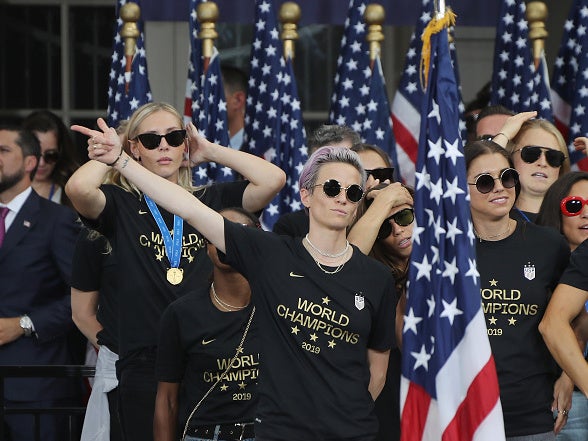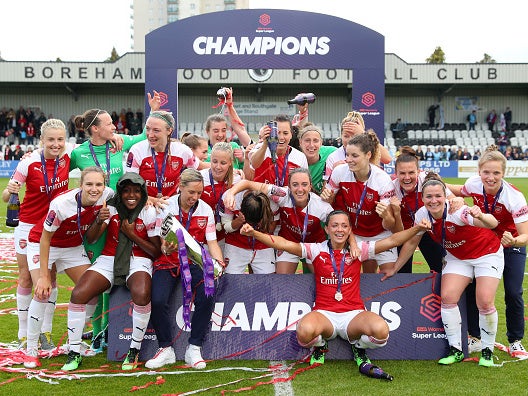How World Cup legacy can transform women’s football from the ground up
The World Cup has established a gleaming perception of the women's game. Now, we must maintain that to take it forwards

Your support helps us to tell the story
From reproductive rights to climate change to Big Tech, The Independent is on the ground when the story is developing. Whether it's investigating the financials of Elon Musk's pro-Trump PAC or producing our latest documentary, 'The A Word', which shines a light on the American women fighting for reproductive rights, we know how important it is to parse out the facts from the messaging.
At such a critical moment in US history, we need reporters on the ground. Your donation allows us to keep sending journalists to speak to both sides of the story.
The Independent is trusted by Americans across the entire political spectrum. And unlike many other quality news outlets, we choose not to lock Americans out of our reporting and analysis with paywalls. We believe quality journalism should be available to everyone, paid for by those who can afford it.
Your support makes all the difference.The legacy of the World Cup, how it thrilled, captivated, inspired and broke hearts, is how women’s football can grow from here.
Ever since the tournament in Canada in 2015, interest has been heightened, sponsors and marketing have increased and the sport is already feeling the trickle-down effect of the summer. The world has been exposed to women’s football. Everyone saw 60,000 people in the stands at the modern, hi-tech Lyon Olympic Stadium and that’s the perception people now have of the game.
We all realise that to capitalise on that, women’s football in England needs regular TV slots, high-quality punditry and coverage so that everything exudes the value of the product. But, equally, there is no point BT or Sky putting on ground-breaking coverage of a game if the first time people watch a match since the World Cup, the stadium looks run down or half-empty, and the pitch is dry, slow and stained by bobbles.
Some of the pitches I play on with Lyon in the French league, and to a lesser extent in the Women’s Super League, are terrible. It’s impossible to ignore. If that’s the first thing people see since watching the World Cup, we’re kind of shooting ourselves in the foot.
From there, to grow the game in England, we’ve got to start focusing on the domestic league. We’ve already seen that the Manchester derby and Chelsea’s opening match are going to be held at the Etihad and Stamford Bridge respectively. I think that’s a really important step. When sponsors, marketers and federations are able to give us that opportunity, it puts the matches on a pedestal where, if players can create those iconic moments like we saw the US do at the World Cup, it can excite people, retain engagement and have a lasting effect.
The US are unquestionably spearheading the game’s growth at the moment. Their players are household idols and Megan Rapinoe, with the backing of her teammates, decided they were going to take care of business off the pitch as well as on it when they were in France. They’re fighting for equal pay, their message is extremely powerful and I really admire the way they’ve done it. We’re obviously some way off being outspoken like that. I don’t think you’ll see the team refusing to visit the Houses of Parliament any time soon, but we do need to build a type of culture where players can be elevated to having the status of a celebrity and are recognised in the streets.

Of course, the US do benefit from quite a unique situation in regard to the profile between the male and female leagues. Whereas the Premier League is arguably the best in the world, MLS pales by comparison and, as we’ve seen with Nike, the women’s team are far more successful commercially in terms of shirt sales and the like. It’s unlikely we can strive for the same stature as that.

What we can do, though, is emulate the structure the US has built. Women’s football in the US has a foundation unlike anything over here, from high school through to college, specialist training programmes that consistently produce some of the best players in the world. We haven’t got that type of pathway here and it makes it a lot more difficult to retain our best young talent.
It’s an attractive dream to go to the US. I’ve considered it in the past, I know Lucy Bronze has considered it too. Women’s football isn’t seen as the crème de la crème at university in England and that’s something we have to try and redefine. The FA are creating more performance centres and talent hubs but that’s going to take a long time to establish. The sooner they are, the sooner we can improve the game from academy level upwards and have a WSL that’s bigger, better quality and more competitive.
Join our commenting forum
Join thought-provoking conversations, follow other Independent readers and see their replies
Comments